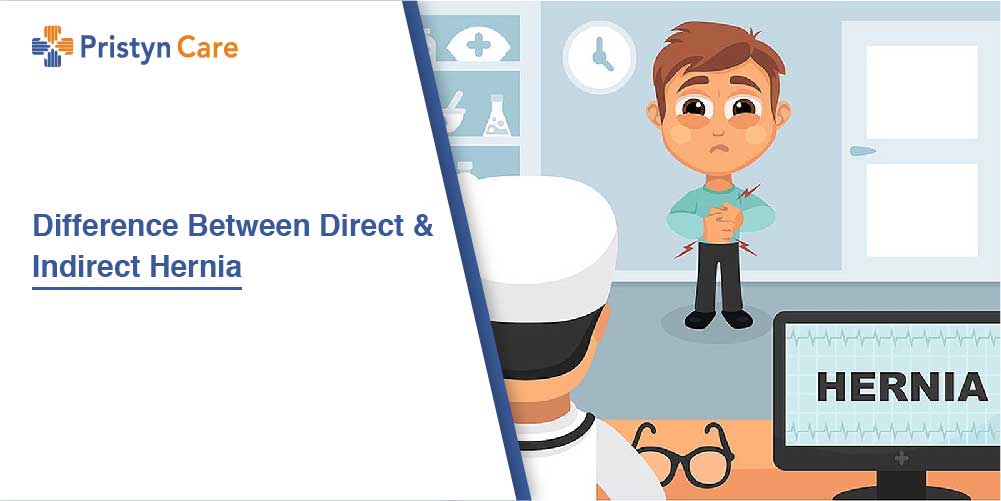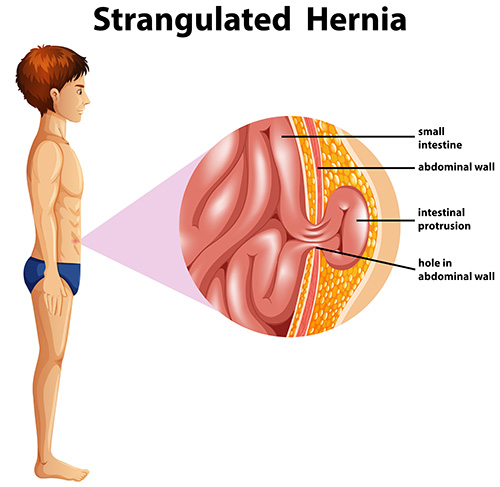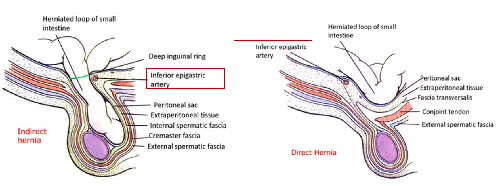
Hernia is a protrusion of an internal organ through the weak tissues that surround it. It has some clinical features such as:
- Lump at the abdominal site
- Increases in size on coughing or straining
- Size reduces when in a relaxing position
A hernia can be categorized into two types-
- Direct hernia
- Indirect hernia
Table of Contents
What is Direct Hernia?
This is a type of hernia that develops over time due to the weakening of the abdominal muscles. This is the most common type of hernias that develop in males.
As the inguinal canal is smaller in women, this type of hernia is less likely to occur in females. Moreover, there is an additional barrier along the inguinal canal in women. This also prevents from development a direct hernia.
Causes of Direct Hernia
The most common causes of developing direct hernia are- aging and stress. Excessive straining can also weaken the inguinal canal.
What is an Indirect Hernia?
An indirect hernia commonly develops in children. It is more common among children because it is a defect in the abdominal wall that is present since birth.
Causes of Indirect Hernia
When the fetus is growing inside a mother’s womb, there is an opening on the inguinal canal that closes before birth.
Sometimes when the opening doesn’t get closed, there are chances that a part of the intestine or other developing organs can slip through, causing a hernia.
Other causes of Direct and Indirect Hernia
- Lifting heavyweights
- chronic constipation
- Smoking
- Being overweight
Inguinal Hernia
There are different types of hernia – Inguinal, Femoral, Umbilical, Incisional and Hiatal. Inguinal hernias are the most common type of hernia that can occur. In this type of hernia, there is the protrusion of a part of the intestine in the groin area through the weak spot.
They occur in the inguinal canals and may extend to the scrotum in males. If you are not able to push back the hernia, the content of the hernia can get trapped in the abdominal wall. This is also known as incarceration.
Inguinal hernias are not dangerous in itself but may lead to significant complications when the blood flow stops to the intestine. It is known as strangulation. The symptoms of strangulation may be nausea, vomiting, fever, sudden pain, inability to bowels and/or hernia bulge turning red or dark.

To make you understand, the area between the hip and the chest is known as the abdomen. The lower abdominal wall is the inguinal region, also known as the groin. The hernia may get back to its place when the person lays down. The risk of hernia increases if you are overweight or you smoke or have a family history of hernias.
Inguinal hernia can be of two types:
- Indirect inguinal hernia
- Direct inguinal hernia

Indirect hernia is caused by the birth defect in the abdominal wall. A direct hernia is usually seen in adult males. It is caused by weakness in the abdominal wall that develops over time due to lifting heavy weight or straining. Direct hernia is common at later stages of life as the abdominal wall weakens with age.
Difference between Indirect and Direct Inguinal hernia
| Indirect Inguinal Hernia | Direct Inguinal Hernia |
|---|---|
| Usually seen in children and young adults | Common in elder people mostly above 40 years of age |
| It may be congenital | It comes along with age when straining or lifting heavy objects |
| Can descend into the scrotum | Cannot descend into the scrotum |
| Pass through the inguinal canal | Bulge from the posterior wall of the inguinal canal |
| It appears as an elliptical swelling | It appears as a circular, symmetric swelling at the external ring |
| Reduces upward then laterally and then backwards | Reduces upward and then straight backward |
| It is not that noticeable as it is behind the fibers of the external muscle | It may be felt in the abdominal wall |
| The reduction of the indirect hernia can be controlled by pressure over the internal ring | Reduction cannot be controlled in case of the direct hernia |
| On standing, indirect hernia takes time to reach to its complete size | Direct hernia appears immediately on standing |
| Similarly, on lying down, there is a delay before the indirect hernia retracts fully | Similarly, direct hernia disappears immediately |
| After the reduction, the bulge appears in the middle of the inguinal region before turning to the scrotum | After reduction, the protrusion appears exactly where it was before |
How do doctors Diagnose Direct and Indirect Hernia?
To diagnose a hernia-whether direct or indirect- the doctor simply performs a physical examination. He can ask the patient to stand and then cough or strain.
For further diagnosis, the doctors also recommend some imaging tests to check where the hernia is located–
- Ultrasound
- Abdominal x-ray
- CT scan
Treatment of Direct and Indirect Hernia
Hernias do not go away on their own, they need surgery in the future whether it is a direct or indirect hernia. Surgery for indirect hernia is usually safe in infants and children. The hernia sac moves away from the scrotum and closes with sutures. In adults, there are two approaches to repair a direct hernia, open surgery and laparoscopic surgery.
In open surgery, the surgeon makes a large incision and places the hernia back in its place. The repairing of the abdominal wall takes place and sometimes he places a mesh to strengthen the abdominal wall.
Laparoscopic surgery is a growing option for abdominal surgeries including hernia operation where doctors make a few small incisions instead of one large cut. A thin telescope-like instrument helps to see inside the abdomen and treat the hernia. Laparoscopic surgery is preferred over open surgery to treat the hernia as it is a less invasive procedure. It involves less scarring and a short hospital stay. Even the recovery time after the surgery is less in comparison to open surgery. Learn more about the benefits of laparoscopic hernia surgery.

Prevention of Direct and Indirect Hernia
Therefore, now you may be able to prevent a congenital problem such as an indirect hernia, but there are some instructions that you must follow to prevent the symptoms of a direct hernia.
- Maintain a healthy weight
If you are obese, then lose weight. It will prevent you from straining your abdominal muscles.
- Increase liquid intake and fiber-rich foods
When you increase liquid and fibre-rich foods in your diet, it may prevent constipation and straining during bowel movements.
- Stop smoking
Smoking causes lung problems and increases coughing which raises the risk of developing a direct hernia.
- Be careful while lifting heavy objects
Whenever you lift heavy objects, use your legs and knees instead of the lower back or abdominal muscles. This will reduce the strain to your lower back.
Conclusion
Inguinal hernia may not show any symptoms or may cause pain, especially when they appear first. Seek immediate medical help from Pristyn Care in case of any of the above problems as delay in the treatment may be life-threatening.
*Disclaimer: The content is written and reviewed as per the expertise and knowledge of the author and reviewer. For a final call related to ailment, we highly recommend people to Consult with a Specialized Doctor and take necessary decisions as per the Doctor’s suggestions.







